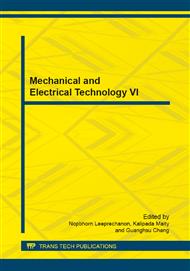[1]
W. -C. Choi and J. -Y. Ryu: Microsystem Technol. 17 (2011), p.143.
Google Scholar
[2]
D.G. Grossman and D. L. Taylor, in The Science of Ceramic Machining and Surface Finishing, edited by B.J. Hockey and R.W. Rice, NBS Special Publication 562 volume 2, US Government Printing Office, Washington DC (1979), p.221.
Google Scholar
[3]
R.W. Rice and B.K. Speronello: J. Am. Ceram. Soc. 59 (1976), p.81330.
Google Scholar
[4]
P. Roth and H.K. Tonshoff, in : Machining of Advanced Materials, edited by S. Jahanmir, NIST Special Publication 847, US Government Printing Office, Washington DC (1993), p.247.
Google Scholar
[5]
C. Guo and R.H. Chand: Ceram. Eng. Sci. Proc. 17 (1996), p.215.
Google Scholar
[6]
T.G. Bifano, T.A. Dow and R.D. Scattergood: Trans. ASME J. Eng. Industry, 113 (1991), p.184.
Google Scholar
[7]
K.H. Kunzelmann and R. Hickel in: Machining of Advanced Materials, edited by S. Jahanmir, NIST Special Publication 847, US Government Printing Office, Washington DC (1993), p.479.
Google Scholar
[8]
J. Quinn, L. Su, L. Flanders and I. Lloyd: Machining Sci. Technol. 4 (2000), p.291.
Google Scholar
[9]
A. Broese van Groenou, N. Maan and J.B.D. Veldkamp in: The Science of Ceramic Machining and Surface Finishing, edited by B.J. Hockey and R.W. Rice, NBS Special Publication 562 volume 2, US Government Printing Office, Washington DC (1979), p.43.
Google Scholar
[10]
J.B. Quinn and G.D. Quinn: J. Mater. Sci. 32 (1997), p.4331.
Google Scholar
[11]
A.G. Evans in: The Science of Ceramic Machining and Surface Finishing, edited by B.J. Hockey and R.W. Rice, NBS Special Publication 562 volume 2, US Government Printing Office, Washington DC (1979), p.1.
Google Scholar
[12]
J.B. Quinn, I.K. Lloyd, R.N. Katz and G.D. Quinn in: Proceedings of the 7th International Cocoa Beach Conference on Advanced Ceramics and Composites: B, edited by W. M Kriven and H. -T. Lin, The American Ceramic Society (2003), p.511.
DOI: 10.1002/9780470294826.ch74
Google Scholar
[13]
A. -b. Yu, L. -j. and Y. -f. Tan: Trans. Noferrous Metals Soc. China 15 (2005), p.243.
Google Scholar
[14]
H. Shin and B.M. Song: Ceram. Int. 39 (2013), p.9815.
Google Scholar


